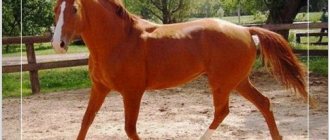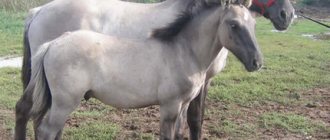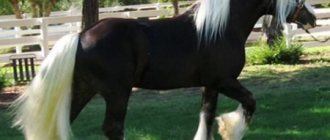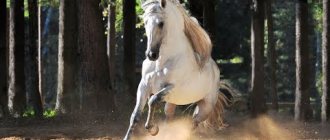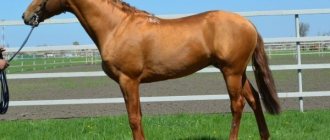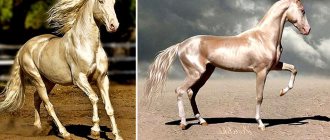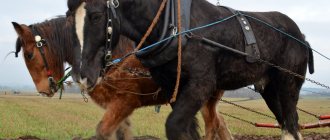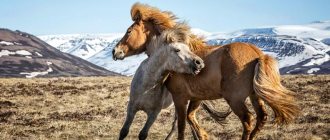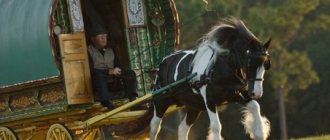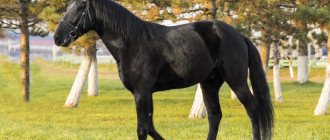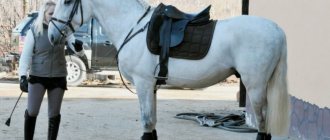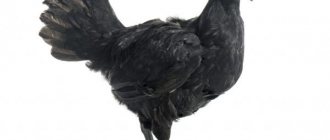Roan color is a unique and rare phenomenon that is common among all breeds of horses. Previously, roan horses cost 6-7 times more in Rus', and presenting such a horse as a gift was considered a manifestation of the deepest respect.
Roan is a color with an abundance of white hair on the body. Most often, the head and limbs retain the color of the main color of the breed, but there are exceptions. The color of the coat does not change with age. The amount of white hair on the rump also varies. From rare veins to entire spots and stripes.
A unique feature of roan horses is skin regeneration . At the site of injury, the animal grows fur of only the primary color. This is a roan gene phenomenon.
Roan color gene
The Rn gene is a dominant trait that is not sex-linked. When crossing animals that both have the roan gene, the experiments ended in the death of all offspring.
The roan gene is not linked to any particular breed of horse, but a horse with a dark base color looks especially impressive.
Color may appear in different ways. Zonal and non-zonal. It depends on how the white hair is positioned. If they lie on the horse’s body in spots or stripes (like the Savras roan), then this is a zonal distribution. If small white hairs alternately cover the entire body. This is non-zonal coverage.
Signs of a noble roan horse:
- Eyes and hooves. Despite the dominant Rn gene, the eyes and hooves should remain dark in color, unless specific to the breed.
- Color constancy. Roan horses never turn gray if their base color is dark. Blonde hair tends to lose color saturation over time. But it will not completely lose pigment. The color of dark horses can become even darker over time.
- Season. Some varieties of roan color change the shade of their coat depending on the time of year. The exception is the mane, which always retains its natural noble shade.
- Tail. It retains its color throughout its life. With the exception of Savras-roan suit. A unique phenomenon is when there is a small white strand in the tail, which looks more like highlighting than a natural phenomenon.
- The former wounds are not visible. Unlike other horse masks, when a roan horse is wounded, hair of the same color grows at the site of the cut. It blends harmoniously with the rest of the color and after a while it is no longer possible to say exactly where the cut was.
Characteristics
The characteristics of a roan horse include the following:
- The main characteristic feature is its noble appearance. Such individuals look impressive, they are well built.
- The color remains from birth to old age.
- In some seasons, dark spots may appear on the animal’s body. It is not a disease.
- This color is observed only in those individuals whose ancestors were wild horses.
- Regeneration. If an area of fur has been damaged, wool of the same color will grow on it.
Photo of roan color
Temper and behavior
Livestock experts note that black horses are inherently willful. This color is a rare species. The color of a horse does not change throughout its life.
There is debate among livestock specialists about the influence of the genotype on the character and behavior of the animal. According to the observations of horse breeders, it was noted that black horses have a complex disposition, bay horses have endurance, and gray horses are sensitive creatures. The behavior of the animal is also influenced by the breed with which the roan was crossed.
Types of roan color
It is generally accepted that roan color is exclusive to horses with black coats. This is wrong. They think so because the white hairs on such horses are more visible. But on cream, red, gray breeds they are simply not noticed. The gene for roan color was found even in Savras and forelock horses.
- Bay roan. The main color of the horse's body is red-brown or dark brown (depending on the breed). And against the background of this bay color there are frequent white hairs, but the tail and legs remain dark in color. This type of roan color is common, but does not lose its uniqueness and grace.
- Raven-roan. The main color of the body is black or black. And contrasting white splashes give the horse a smoky blue color. Dark legs and a black mane give the animal graceful elegance and fabulousness. From afar, the color can be mistaken for lilac or blue. That’s why horses of this type are called blue.
- Red roan. Or as they are also called – pink horses. Because the base color of the body is reddish-red, the roan gene gives the appearance of a pink color. A unique phenomenon.
- Savraso-roan. A distinctive feature of this coloring is the dark stripes and spots along the horse’s croup. Such horses are also called wild or steppe. Because this is mainly characteristic of this type of animal. Also, unlike other species, a horse of Savras-roan color will have a tail with gray, long hair. This gives a special charm to this breed.
- Nightingale-roan. Not all experts distinguish this color as a separate species. Because in the spring, a gray-haired horse takes on a fawn color. A rare occurrence among all horse breeds.
The most shades and colors are represented in the Bashkir horse breed.
History and origin
In nature, wild stallions have evolved, and individuals of black color appeared, which are considered rare specimens. Breeding specialists are now monitoring this feature. The name of the suit comes from the Turkic language, translated the word “chal” means gray-haired. Giving such a horse as a gift to a local resident was considered a sign of deep respect.
This color is considered a unique natural phenomenon; a horse with this color is a very rare type of representative of the animal world. It is noteworthy that when the skin is damaged, wool of the main color grows in this place.
Difficulties in breeding roan horses
Horse breeders have many problems in breeding this type of horse. The main one is foals. When crossing a horse and a horse with the Rn gene of a roan color. The foal is stillborn or dies within a month. Experts associate this problem with the immune and nervous systems. The mutated integumentary cells of the parents are fully transmitted to the foal and the fragile body cannot cope with external factors.
Some horse breeders breed roan animals by crossing one gene carrier at a time. Those. a roan horse with a normal color horse. But the result will be 50/50. If the foal survives, there is a 50% chance that it will have an active roan gene. Such indicators repel horse breeders because they are not profitable. Therefore, it is difficult to meet a specially bred roan horse, and it is not easy to meet a non-specially bred one either.
Attractive breeds
A roan horse can have almost any breed; the color is not considered rare. Roan is inherent in many breeds, especially the local aboriginal type: Bashkir, Yakut, Altai, Kustanai, Quarter Horse, Appaloosa.
This color feature is never found in Oryol trotters, Arabian horses, and shires.
When breeding horses, they try not to select parental pairs where roaning is present in both parents. The fact is that the roan gene, inherited from both parents, often leads to the death of the foal while still in the womb.
The fixation of interesting colors in the inheritance of horses has long been of interest to scientists, but so far there has been no tangible success in this matter. One can only guess whether the roan gene will manifest itself in the offspring or not.
Famous "bays"
Old Billy
Bay horses are regular participants in various sports competitions and races, they win first places and often become record winners, whose names fit into the “horse” history:
- Thus, the longest-living record holder is a gelding named Billy. While the average horse lives 25 years, he lived a whopping 62 years. And his life was not strewn with roses, all his life from birth to death, he towed a barge along the coast.
- Vulcan is a heavy truck, which back in 1924 was able to carry luggage weighing 29.5 tons.
- The dark bay horse Nearco is the progenitor of many champions who annually win prestigious competitions.
- Picolo Ribot is an Italian horse who has never known what losing is, since he has only winnings in his piggy bank. He managed to reach the finish line, ahead of his rivals by several lengths.
Picolo Ribot
- The best English riding horse that has been officially recognized is Frankel. It was valued at a record $200 million.
- An elegant and beautiful horse, Poetin , with a tragic fate, received from fans the nickname “Ballerina” and the more prosaic nickname “Million Dollar Baby.” She has shone since 2000 at various conformation competitions, where she was always among the favorites, and in competitions the judges rated her gallop, trot and walk very highly, often giving her the maximum score.
Wild colors
Despite the fact that all wild colors, for example, savras, mousey, and brown, are derivatives of the main ones, they all have additional distinctive features. These include notable features of wild horses, namely zebroid on the legs, undercoat (white tan markings in the groin, on the muzzle), and a dark stripe along the spine. Sometimes there is a stripe on the shoulders, like donkeys have “wings”. Therefore, it is more expedient to separate them into a separate subgroup. If you want to know what a mousey horse is or why the savras suit is called that, then don’t miss our review.
| Name | Photo | Description |
| Savrasaya | Savras color is inherent in wild Przewalski horses, and is also less common in half-blooded breeds. The color of the main covering hair is faded red with undertones, but it is distinguished by a dark brown or black mane, tail and lower legs. There may be individual gray strands at the edge of the mane and tail, like a gray horse, for example, of the Norwegian Fjord breed. The name is borrowed from the Turkic “pure yellow”. | |
| Kauraya | The brown horse, also known as the red-brown horse, is distinguished by its light red color with all the inherent wild features. The mane and tail are a shade darker. | |
| Mousey | A very rare color, a legacy of ancient forest and steppe horses. Tarpans were mousey, and now the horses are of the Polish Konik breed. The coat of such horses is ash-gray, almost grey, with a black mane and tail. Often in summer the main color acquires a brown tint. |
Breeding, maintenance and care
Caring for roan horses is no different from keeping other species. Individuals are kept in herds or in stables, it depends on the climatic conditions of the region. In warm climates, horses can graze year-round with shelter and constant access to water. If there is enough grass on the pasture, there is no need to feed the animals additionally. When grazing horses on meager fields, hay and oats are introduced into the diet. If possible, the pasture is sown with special grass, for example, timothy grass is used.
In the stables, animals are fed 3-4 times a day. The same quantity is provided with drinking water. On hot days, the amount of liquid in the horses’ diet is increased. Horses kept for physical work or competition are fed more often than others.
The main part of the diet should be: barley, oats, corn, rye and wheat. Animals are not given water after walking in fields of legumes and clover. Fluid in the body causes bloating. Individuals of the roan color are a great source of pride for farmers, especially if the background color of the animal is black. To breed a stallion of this color, breeders carefully select a pair of parents.
Characteristic
Throughout their history, horses have adapted to new climates and human demands, they have been crossed and modified. All this made it possible to obtain many breeds. A breed is a set of distinctive characteristics unique to only one group of horses.
In addition to the breed of the animal, its color is also determined. Suit is a genetically determined type of distribution of hair pigment. The color of bay horses became the most common.
Temperament
There is a common misconception that color affects the character of a horse. This theory appeared back in the Middle Ages. In particular, the famous hippologist Pinter von der Au cited the following relationship between the character and color of an animal:
- gray color (he called it white) - water (he believed that light horses were more phlegmatic and calm);
- red color (here he included all representatives of the red and bay colors) - fire (sanguine horses);
- black color - earth (he classified representatives of this breed as melancholic).
Also known are the remarks of the hippologist Lenaisse, in which he defines red and bay horses as angry, with a hot nature, and about black animals he says that they have a “cold, dry inner quality.”
As is easy to see, these classifications were based on the parallels that people drew between the appearance of the animal and the surrounding nature. This is not at all surprising, given that at the time this stereotype appeared, science relied heavily on religion, everyday ideas about the nature of things, and even alchemy. The origin of the names of the suits also serves as a kind of indicator.
For example, the word “bay”, according to different versions, has the following origin:
- according to one version, the name of the bay color comes from the old Russian word “gnedit”, which corresponds to the modern “to kindle a fire”;
- another version is based on the fact that in Latin there is a word similar in spelling nidor (Latin “burn, soot, smoke”).
Modern science claims that there is no connection between the color of a horse and its disposition. However, there is a direct connection between a horse’s color and its physiological parameters. For example, bay horses are considered stronger and more resilient.
Interestingly, most breeders express opinions in support of a long-standing stereotype. They note that such horses are excitable and violent, and have a capricious, hot character. At the same time, many breeders say that these are very loyal, calm animals that are easy to train. Hippologists note that although color has an indirect effect on the character of the animal, it is still not a determining factor. Of great importance in shaping the character of a horse are its breed, conditions of keeping and education, as well as contact with humans.
Appearance
The Savras horse is considered the ancestor of modern bay horses. This breed lived in Europe and its closest existing relative can be called the Przewalski breed. Savras horses had a number of pronounced characteristics that, to one degree or another, are manifested in modern bay horses.
- The lower parts of the legs have a darker shade in relation to the main color or even black. Horses of the Savras breed had a sharp transition from one color to another; among modern representatives of the bay color this transition is “stretched out.”
- Bay horses range in color from light fawn to dark chocolate shades. Horses with white patches are often found.
- Thoroughbred bay horses have golden or brown eyes.
- The mane and tail should be the same shade. They can be black or a shade darker than the main color.
Character
The horse has a wonderful character. He is simple and obedient, thanks to the influence of Arab blood. At the same time, it is hardy due to its heavy origin. The Boulogne can develop very quickly and maintain speed for a long time, which is why it was often used in crews. The amazing elegant appearance, partly adopted from the Arabian horse, distinguishes the breed from all other heavy draft horses. The movements are light and energetic, even at high speed.
As early as 18 months, young horses can begin to work, receiving the same loads as adult horses. It can work for many hours without getting tired, but in this case it also requires more care and attention, since hard work often affects health, and especially the legs and hooves.
Varieties
Raven-roan
The horse boasts the most unusual color. By merging the black base color with the gray hairs, a smoky coat is formed, which looks very attractive. When certain rays hit, you can see reflections of a bluish or purple color. For this reason, they are often called blue by the common people.
The mane, tail and hooves of this species are always dark in color.
Bay roan
It is the most common today. It is characterized by variations from brown to dark brown and even red. In this case, the hairs are distributed unevenly over the body; they do not cover the head and lower part of the legs, which retain the main shade. In addition, the mane and tail remain dark. Despite its wide distribution, the bay roan does not lose its uniqueness.
Savraso-roan
The horse is also often called a steppe horse. This is due to external features that are very similar to their ancient ancestors who lived in the steppes.
This species can be distinguished by markings and stripes of a darker tone located along the body. Gray strands in the tail and mane are an individual feature and give the breed a certain charm.
Despite everything, it is very often confused with the light bay color, but it should be remembered that the light bay horse has much more grayish hair.
Red roan
The suit is highly valued nowadays. The second name is pink horses. The pink tint is created due to the whitishness and their rich red color - natural color. Like the raven roan, the lower limbs, head, and mane and tail are free of gray hair.
Nightingale-roan
The suit is one of the most amazing. The main color itself is very rare, and accordingly, roan is even rarer. The amazing thing is that with the change of season the color of the horse changes. With the arrival of spring, the horses turn fawn. They are sometimes called gray horses because the gray hairs appear gray against the background of the light coat. Unlike other colors, this one has retained its originally light mane and tail.
Damn horses
Quite rare too. This is truly an incredibly beautiful suit. The main color is golden, but you can also see light beige and even bay. The lower parts of the front and hind legs are deep black, as is the mane and tail.
Voronaya (Black)
Black horses have black hair, skin, and eyes. There are individuals that can fade in the sun, and there are those that always remain black (they are called non-fading black, raven black or jet black).
Black handsome men are quick-tempered and capricious; owning a black horse is the dream of every equestrian connoisseur. Among the nomads, the black horse was known as a symbol of admiration, and was the most expensive gift for any family. In the cultures of other nations, a black horse is a harbinger of troubles, a mediator between man and otherworldly forces.
The black horse was distinguished by its magnificence on the battlefield, instilling horror and awe in the enemy. This is exactly what the famous Bucephalus was like, which belonged to the conqueror Alexander the Great.
The black suit has several variations:
- Tanned black (dull black, dusty black or fading black). This horse is distinguished by its ability to burn out under the rays of the summer sun. The black pigmentation of such horses is unstable, and if the horse has to spend a lot of time under the scorching sun, the color may change from black to almost brown. But with the arrival of winter, such horses turn black again.
- Silver black (silver black or chocolate silver). This type includes individuals whose body is black, and the hair of the mane and tail is silver. In addition, the body hair is lightened due to silver hairs.
- Smoky black or ash black (smoky black). The hair color is less saturated and has a special tint - chestnut or chocolate. In winter, “smoky black” horses do not turn pure black, unlike “black and tan” horses.
Smoky black horses can be very similar to dark brown horses, but the smoky black has a black mane and tail, or nearly so. But it’s better to look at the horse’s pedigree to accurately determine the suit.
The color of the hooves of black horses is black. The determination of color is not affected by the presence of white markings - they are quite acceptable on black horses.
Links[edit]
- " Roan
"
And n.1
" Oxford English Dictionary. 2nd edition 1989 OED Online. Oxford University Press. June 3, 2008. < https://0-dictionary.oed.com.helin.uri.edu/cgi/entry/50207603 >. - ^ abcde Laboratory of Veterinary Genetics. "An Introduction to the Genetics of Coat Color". Regents of the University of California. Retrieved June 4, 2008.
- ^ abc "Roan Zygosity Test Information". Veterinary genetics laboratory services
. University of California at Davis. Retrieved October 1, 2009. - Marklund, S; M. Moller; K. Sandberg; L. Andersson (1999). "Close association between sequence polymorphisms in the KIT gene and roan coat color in horses." Mammalian genome
.
10
(3): 283–288. DOI: 10.1007/s003359900987. PMID 10051325. - Overton, Rebecca (2004-12-15). "In the Genes" (PDF). Quarter Horse News
. American Quarter Horse Association. pp. 24–6. Archived from the original (PDF) on September 27, 2007. Retrieved June 4, 2008. - ^ a b Schmutz S.M.; T.G. Berrier (2007). "Genes affecting coat color and pattern in domestic dogs: a review." Animal Genetics
.
38
(6):439–549. DOI: 10.1111/j.1365-2052.2007.01664.x. PMID 18052939. - ^ ab Schmutz, Sheila (2007-11-12). "Spotted Patterns". Genetics of dog coat color
. Retrieved June 4, 2008. - Cocker - spaniel club. "Roan". Cocker Spaniel Colors and Markings
. Retrieved June 4, 2008. - ^ ab Byrne, Georgina (1990) [1990]. "Gene loci for coat color and pattern." Der Deutsch Kurzhaar, German Shorthaired Pointer
. Georgina and Michael Byrne. ISBN 1-86307-006-0. - Clark, Los Angeles; J. M. Wahl; CA Rees; KE Murphy. "Introduction of a retrotransposon into SILV is responsible for merle patterning in the domestic dog." Proceedings of the National Academy of Sciences of the United States of America 103
. pp. 1376–81. - Jump up
↑ Ibsen, H. L. (1999).
"The Cattle Inheritance." Genetics
.
18
: 441–482. in Seitz et al. (1999) - Schmutz, Sheila (2004-02-17). "Chalay pattern". Genetics of coat color in cattle
. Retrieved June 3, 2008. - ^ ab Seitz, Jeffrey J.; Schmutz, Sheila M.; Thue, Tracey D.; Buchanan, Fiona S. (1999). "A missense mutation in the bovine MGF gene is associated with a roan phenotype in Belgian Blues and Shorthorns." Mammalian genome
.
10
(7): 710–712. DOI: 10.1007/s003359901076. PMID 10384045. - Seitz, Schmutz, Thue and Buchanan: "Although both Charolais and White Park can be classified as white phenotypically, all typed r/r are homozygous) at the MGF locus. Alternative loci must be responsible for these forms of whiteness, as previously proposed (Olson and William 1982)."
- Charlier, C; Denis B; Belanche JI; Coppieters W; Grobet L. (1996). "Microsatellite mapping of the roan cattle locus: a major determinant of white heifer disease." Mammalian genome
.
7
(2): 138–142. DOI: 10.1007/s003359900034. PMID 8835531. in Seitz et al. (1999) - Longley, B. Jack; Greg S. Morganroth; Linda Tyrrell; Tie Gang Ding; Dirk M. Anderson; Douglas E. Williams; Ruth Halaban (May 1993). "Altered mast cell growth factor (c-kit ligand) metabolism in cutaneous mastocytosis." New England Journal of Medicine
.
328
(18):1302–1307. DOI: 10.1056/NEJM199305063281803. PMID 7682288. - Schmutz, Sheila (2004-02-13). "Conditions associated with coat color". Genetics of coat color in cattle
. Retrieved June 3, 2008.
Rare colors
However, this is not the entire list of possible colors of horses. There are even more unusual and rare horse colors. Sometimes their color simply amazes with its diversity and possible variations.
| Name | Photo | Description |
| Isabella | This is a rare color that is found only in certain breeds. Most often it can be found among Akhal-Teke and Welsh ponies. In America and many other countries they call it “cream”. Such horses have a yellowish tint to their coat, which gives its own unique tint of baked milk on the pink skin. These are not albinos, since Isabella horses have blue eyes, not red. | |
| Chubaraya | Chubara is one of the most ancient suits, known from the culture of Central Asia. Most often it is characteristic of local aboriginal breeds (Altai, Kazakh, etc.). This is a very complex color, as it is formed by two colors. It is often called leopard print, although the forelock color has many variations. Its main difference is the presence of small specks and spots on a dark or light background. The mottled color is most pronounced among Appaloosa horses. | |
| Piebald or pinto | Horses that have two or more colors due to existing spots are called Pinto. Large spots are scattered against the background of the main color. Depending on the size and location of these spots, different types of piebaldity are distinguished. In America, such horses are especially valued and were previously bred exclusively by Indians. Here they received a separate name “Pinto”, which is often confused with the breed. Pintos are all piebald horses, like the black stallion with white spots in the photo. | |
| Silver | An unusual rare type of color that is found in both primary and derivative colors. Characterized by the presence of a gray tint. Silver or gray color is also inherent in the mane and tail, especially in individual strands. The silver-black horse looks especially elegant, where the black horse has a gray mane and tail. | |
| White dominant or white born (albino) | These albino horses are distinguished by having white skin immediately at birth. Very rare, as in ancient times it was considered a defect and was discarded as an albino. Today, white-born horses (albinos) are valued more, and in America, the Albino Horse Club was created especially for such albinos. |
Classification
In the modern world, there are several classifications, one of the most common is the division into background and composite suits. At the same time, the background color is usually divided into groups: zonal, that is, close to the color of the ancient wild ancestors, with a smooth transition from light to rich dark tones. And non-zonal, respectively, evenly colored. These include, for example, brown, bay, and nightingales.
Composite suits are colors developed by interspersing white admixtures with the background suits. Just like background suits, composite suits are divided into 2 groups: mixed and spotted. An example of the first group would be a gray horse, and the second group would include a forelock horse. The untrained eye will not be able to detect the difference.
Bay horses in art
The crew of Governor Zakhary Korneev
The grace and beauty of this color could not fail to interest people of art - artists, sculptors, directors, poets.
Belarusian sculptor Vladimir Zhbanov gave life to the sculptural composition “Crew of Governor Zakhary Korneev”, installed in Minsk.
Two bay horses harnessed to a phaeton won the love of townspeople and tourists. Copies of this sculpture migrated to Russian cities. They can be found in Tobolsk under the name “A Pair of Horses Harnessed to a Carriage”, in Kursk under the name “Governor’s Carriage” and in the town of Dolgoprudny near Moscow.
Poets also did not stand aside and dedicated lines of poems to these magnificent animals, and the romance “A Pair of Bays” was written based on Apukhtin’s poems, which became a classic.
Cinema and horses are inseparable, especially when it comes to filming films with military, historical, and adventure themes. Bay horses often appear in films - “War and Peace” by Bondarchuk the Father, “The Elusive Avengers” and others.
There is a subgenre in painting - ippic, from the Greek word hippos - horse. Many artists in the 18th and 19th centuries depicted bay horses in their landscapes, battle paintings, and ceremonial portraits.
In these times, the horse played a significant role in human life - it was a means of transportation, a breadwinner and a faithful friend on the battlefield.
Application
Horses of this color are universal. Their endurance and strong physique allow them to be used for heavy work on farms. The speed, maneuverability and jumping ability of such animals ensured their popularity in equestrian sports. They are often entered into competitions in driving, show jumping, rodeo, cross-country, and harness riding.
The appearance of the horses did not go unnoticed. Thanks to her, such horses are often attracted to various exhibitions, shows, and special events. Also, spotted horses can often be found in the circus.
Chubby color in horses is relatively rare. In addition, it is extremely difficult to breed such horses on a private farm. Therefore, these animals are valued much higher than stallions and mares of standard colors. Obviously, the care of such living creatures must be appropriate in order to preserve and increase such a rare species.
Gray
The gray color is formed due to the early graying of any of the possible colors. Because of this, it is very common. Animals begin to turn gray at different times, sometimes even before birth. Gray horses are usually born hyperpigmented, with a pronounced presence of pigment in the coat and hair.
The gray coat retains the color of the eyes, skin and hoof horn, only the base color of the hair changes. The shades of the gray horse are very diverse, from light gray to pink and red-gray. Gray horses with apple or buckwheat patterns are often found. Gray horses are found in almost all breeds.
Buckwheat gray: Wikipedia
What does "bay" mean?
Where did the word “bay” come from and what does it actually mean? The word does not have a generally accepted etymology, since linguists themselves do not have an exact answer to this question.
But there are two explanations that deserve attention:
- the word is of Czech origin and is a derived form from “snĕdý” - “dark”;
- from the verb “to oppress”, “to kindle”, “to brown”, that is, “bay” literally means “the color of fire” - a fiery or red color of a dark tone.
